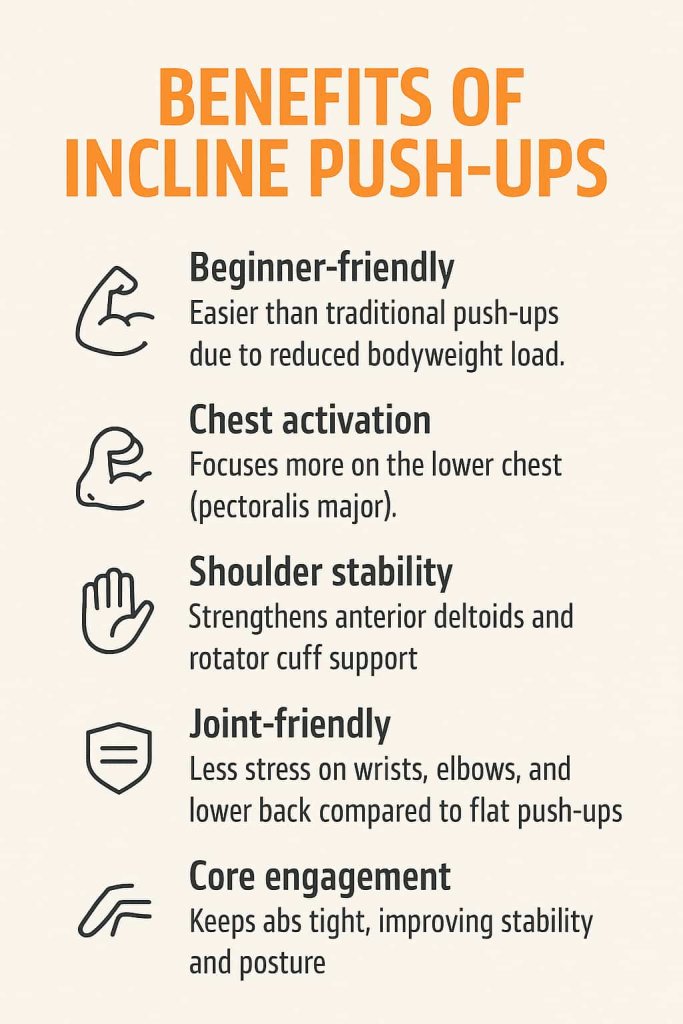Incline push-ups are one of the best exercises to strengthen your chest and shoulders while being easier on your joints than standard push-ups. By elevating your hands on a bench, step, or wall, you reduce the load and create a more accessible movement that still delivers results.

Incline push-ups are essential for beginners, people recovering from injury, or anyone who wants to refine push-up technique while still building strength. They target the chest, shoulders, triceps, and core, while offering multiple variations to keep your workouts effective and progressive.
This guide breaks down the 5 best incline push-up variations, their benefits, how to perform them, and trainer tips—so you can build strength safely and effectively.
How to Do Incline Push-Ups (Step by Step)
- Find a surface → Use a wall, sturdy bench, box, or step. The higher the surface, the easier the exercise.
- Set your hands → Place palms shoulder-width apart on the elevated surface. Keep wrists under shoulders.
- Walk feet back → Step your feet backward until your body forms a straight line from head to heels.
- Brace your core → Engage your abs and glutes to prevent sagging hips or arching back.
- Lower your chest → Bend elbows at about 45° to your sides and slowly lower chest toward the surface.
- Push up → Drive through your palms to extend arms back to the starting position.
Trainer Tips:
- Keep your neck neutral by looking slightly ahead, not down.
- Inhale on the way down, exhale as you press up.
- Aim for smooth, controlled reps instead of rushing.
Benefits of Incline Push-Ups

- Beginner-friendly → Easier than traditional push-ups due to reduced bodyweight load.
- Chest activation → Focuses more on the lower chest (pectoralis major).
- Shoulder stability → Strengthens anterior deltoids and rotator cuff support.
- Joint-friendly → Less stress on wrists, elbows, and lower back compared to flat push-ups.
- Core engagement → Keeps abs tight, improving stability and posture.
5 Incline Push-Up Variations for Chest & Shoulder Strength
1. Wall Push-Ups
Best for complete beginners or rehab training.
How to Do It:
- Stand about two feet away from a wall.
- Place palms on the wall at shoulder height and width.
- Bend elbows and bring chest toward the wall.
- Press back to the starting position.
Trainer Tip: Keep your core tight to avoid arching your back.
2. Bench Incline Push-Ups
The classic version that balances chest and shoulder activation.
How to Do It:
- Place hands on a sturdy bench, step, or box.
- Walk feet back until your body forms a straight line from head to heels.
- Bend elbows and lower chest to the bench.
- Push back up until arms are fully extended.
Muscles Worked: Lower chest, shoulders, triceps.
3. Incline Diamond Push-Ups
Targets the triceps and inner chest more directly.
How to Do It:
- Place hands close together on the bench, forming a diamond shape with thumbs and index fingers.
- Step feet back into push-up position.
- Lower chest toward the diamond hand position.
- Push back up, keeping elbows tucked.
Trainer Tip: Move slowly to protect elbows.
4. Incline Archer Push-Ups
Advanced unilateral strength builder.
How to Do It:
- Place hands wide apart on the bench.
- Lower your body toward one hand, keeping the opposite arm straight.
- Push back up to the middle.
- Repeat on the other side, alternating reps.
Benefits: Improves unilateral chest and shoulder stability.
5. Incline Plyometric Push-Ups
Explosive variation for power and muscle growth.
How to Do It:
- Place hands on a bench in standard incline push-up position.
- Lower chest toward the bench.
- Push explosively so your hands lift off the bench.
- Land softly and immediately lower into the next rep.
Trainer Tip: Attempt only if you can do 15+ clean incline push-ups.
Common Mistakes to Avoid
- Sagging hips: Keep your body in a straight line to avoid lower back strain.
- Too much elbow flare: Keep elbows at about a 45° angle for shoulder safety.
- Shallow reps: Lower until your chest is close to the surface for full activation.
Incline Push-Ups vs. Decline Push-Ups
| Feature | Incline Push-Up | Decline Push-Up |
|---|---|---|
| Difficulty | Easier | Harder |
| Target Area | Lower chest, shoulders | Upper chest, front delts |
| Best For | Beginners, endurance, rehab | Intermediate–advanced strength |
(Source: Madbarz, 2024)
FAQs About Incline Push-Ups
1. Are incline push-ups good for building muscle?
Yes, incline push-ups build muscle in the chest, shoulders, and triceps, especially for beginners or those working at higher rep ranges.
2. How many incline push-ups should I do per day?
Start with 2–3 sets of 10–15 reps, 3–4 times per week, depending on your fitness level.
3. Do incline push-ups work the upper or lower chest?
Incline push-ups emphasize the lower chest more, while decline push-ups target the upper chest.
4. Can incline push-ups replace bench press?
They can build strength and endurance, but won’t match the progressive overload of heavy bench pressing. Use both if possible.
5. Are incline push-ups safer than regular push-ups?
Yes, because they reduce the load on shoulders, elbows, and wrists, making them ideal for beginners or those with joint issues.
6. What equipment do I need?
A wall, sturdy bench, step, or plyo box—all are perfect for incline push-ups.
Conclusion
Incline push-ups are a simple yet powerful exercise for building chest, shoulder, and tricep strength while staying joint-friendly. Whether you’re a beginner starting with wall push-ups or an advanced lifter adding plyometric versions, these variations can level up your training.
